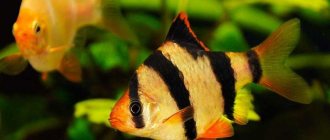Colorful, active, and hardy, barbs are a great addition to any aquarium with appropriately sized inhabitants. These lively, colorful, cheerful fish are able to adapt to various conditions. Barbs are a good choice for beginners because they are unpretentious in maintenance and food. Reproduction of barbs is not a very difficult process, even an amateur can do it. Requires little more effort and planning than breeding viviparous guppies. Guppies give birth to fry, and barbs lay eggs.
Most of this species are small in size, but they need a lot of space to swim. Some varieties love plants and use them as shelter. Almost all types of barbs prefer soft, neutral water that is well aerated.
Since these are very energetic fish, they can be intolerant and noisy for the calmer and slower inhabitants of the aquarium, so it is recommended to keep them in numbers of 6 or more individuals. Barbs are not the best neighbors for fish with long fins.
Main differences between female and male
Barbs are highly valued for their bright colors and unpretentiousness. Among individuals of this species, green-colored mutants often appear, including albinos. But sexual characteristics are poorly expressed.
Until the fish reach full sexual maturity, it is quite difficult, and sometimes impossible, to distinguish between a male and a female.
To determine gender differences, you need to wait until the age of the aquarium inhabitants reaches one year. The main differences are:
- males are smaller;
- externally, females are larger, the body has smooth lines;
- with the onset of the mating season, the males' nose becomes bright red;
- before spawning, the belly of representatives of the species is rounded and significantly increases in size, as caviar accumulates inside;
- males have lighter colored nostrils;
- The body color of females is less bright, sometimes faded and unattractive.
Barbs are considered cannibals. They are able to eat not only eggs, but also their own offspring. In order for the fry to survive, immediately after the cessation of spawning, the producers must be removed from the spawning tank, that is, transplanted into a common aquarium.
When does puberty occur?
Barbs are completely ready for reproduction at the age of 5–9 months. Females develop much faster. They mature approximately 1–1.5 months earlier than males.
There are varieties that reproduce much later. So the shark barb reaches maturity at the age of 1.5 years. That is why this species is often not bred in amateur aquariums.
There is a main sign by which one can determine that the female is ready for spawning - the belly increases significantly in size. To get healthy and “rich” offspring, you need to choose the right barbs.
Females are sorted according to the largest and most well-rounded bellies. They are visible to the naked eye. When selecting a male, you need to pay attention to the most active barb. It is important that it has a particularly bright and beautiful color.
Description of popular types
There are a large number of types of barbs for the aquarium, here are some of the most popular:
Sumatran barbs (Puntigrus tetrazona)
Also called Tiger barbs, these are strikingly beautiful tropical fish. Its arrow-shaped body is luminous, gilded, and has four black vertical stripes. The caudal fin is highlighted with bright orange markings above and below, making the colorless middle part almost invisible. There is an orange color on the pectoral, pelvic and anal fins. In an aquarium, fish easily grow up to 5 cm, some individuals can reach 7 cm.
Fire barb (Puntius conchonius)
The fish are red and gold in color, reaching a size of 15 cm. They feel good in schools with two females for each male. They are prone to aggression if not kept in a group. One of the most popular and affordable fish for aquarium lovers. This is an active fish with a peaceful nature and bright colors. Both sexes have black speckles on their fins and sides.
Black-striped ruby barb (Puntius nigrofasciatus)
It gets its name because the female Black Ruby Barb turns a bright, deep red color when it reaches breeding age. They are peaceful fish measuring 6.5cm in size and are easy to care for and should be kept in groups of five or more. Well compatible with tiger barb.
Barbus Denisonii (Puntius denisonii)
This variety reaches a size of 15 cm. A black line runs along the entire silvery body, which contrasts with a shiny red line that runs just above the black one, reaching the middle of the body.
The dorsal fin is also bright red and the caudal fin is striped with black and yellow stripes. This is an active, schooling species that requires a lot of swimming space. It is better to keep with neighbors of the same size. In recent years, a gold variant has emerged that has a red stripe but no black stripe.
Golden or Chinese barb (Puntius semifasciolatus)
It reaches 7.5 cm in size. The bright yellow color of the body is the result of a mutation. It was artificially bred by Thomas Schubert in the 1960s. The natural color of this fish is green, but it is rarely found commercially due to the popularity of the gold form. Almost all specimens currently sold were created in captivity. There are several other color variations, such as albino and tricolor.
Barb (Barbonymus schwanenfeldii)
The largest representative of barbs. This is a gregarious species, reaching 35 cm in length. Should only be kept in large aquariums. A distinctive feature is the white and black stripes on the outer lateral rays of the forked caudal fin and the white and black end of the dorsal fin.
Four-line barb (Puntius johorensis)
An attractive and peaceful species, this species is not often found on sale. Unlike many members of this family, it has horizontal stripes rather than vertical ones. Because of this feature, in Western countries it received the name Zebra Barb. Although they are not very large (12 cm), they are quite active and therefore require a larger aquarium for swimming.
How to choose good individuals for breeding?
If you plan to breed barbs yourself, you need to select at least six fish. This amount will be quite enough to get strong and healthy offspring. Barbs should be placed in a large and free aquarium.
It is important that the number of females to males is 2:1. After purchasing fish, they need to be quarantined in a separate aquarium.
After observing the barbs, you can notice how the males begin to pay attention to the female. This means that the spawning period is approaching.
There are situations when several males care for one female. In this case, you need to choose the most beautiful one, who will pass on his genes to his offspring.
What determines the success of barb breeding?
So that the fry and eggs do not die over time, it is necessary to study the characteristics of reproduction. The result largely depends on how accurately the rules are followed.
When selecting parents, they are guided by the following criteria:
- The appearance of aquarium fish is only healthy. Male representatives with deviations and deformities are not used.
- Fish parameters.
- Lack of mutants in the pack.
- Degree of activity.
It is not recommended to use phenotypes that have a sickly appearance for reproduction. After all, the drugs used for treatment harm the eggs.
The barb breeding process is simple. But to obtain healthy offspring, certain rules must be followed. Beginners should involve experienced aquarists in this procedure in order to avoid erroneous actions.
Video about the spawning of cherry and Sumatran barbs
AdminAuthor of the article
Did you like the article?
Share with your friends:
Preparing the fish
It is required in advance to seat different-sex individuals in separate tanks. Isolate fish no later than 10–14 days before spawning. But we must not delay. If the males are left too long, they begin to fight. Females that do not have the opportunity to mark for a long time begin to get sick.
Feed barbs ready for reproduction with frozen, but preferably live, food. About a third of the diet should consist of oatmeal. It is useful to give tablets with spirulina. About a day before spawning, a fasting day is done.
If males are ready to spawn, they begin to show aggression. You can determine if a female is pregnant not only by an enlarged belly, but also by a swollen anus.
Individuals of normal size, without defects in color and structure, are suitable for breeding.
Mating games
It is required to select two manufacturers. If the queen begins to attack too much and attack the male, it is better to replace him, otherwise you may be left without offspring at all.
There must be algae in the tank, as it provides protection to the parents. When the fish calm down, they are quickly transplanted into a common aquarium. The completion of spawning is also indicated by the behavior of the female, as she begins to avoid contact with the male.
Approximately 12 hours after the completion of spawning, eggs without an embryo can be identified - they become white and cloudy. It can be easily removed using a pipette.
After finishing
- After marking is complete, place the barbs in a community aquarium. The female is removed from the remains of eggs, which threaten cyst formation, by lightly stroking the abdomen in the direction of the anus.
- Reduce the water column to 10–12 cm. Change 1/4–1/3 of the water.
- To prevent fungal diseases, treat the vessel with liquid methylene blue (C16H18ClN3S). For disinfection, it is sufficient for the medium to acquire a faint blue color. Start air purge.
- After 10–12 hours, remove the separator from adhering eggs and remove. Remove unfertilized white eggs (they are transparent with the offspring).
How does spawning work?
The reproduction process occurs quickly. To do this, you need to properly prepare the fish and spawning ground. Reproduction of barbs will not cause any special problems even for novice aquarists.
Spawning tank
To transplant barbs that are ready for breeding, prepare a separate aquarium with a volume of 10–15 liters. A tank of this size is only needed for one pair. Follow these tips for preparing your spawning tank:
- Place floating plants in the aquarium, in which the female can hide from an overly active male. Monosolenium, hornwort and Java moss are perfect for this. The algae will also be useful for the fry.
- Prepare the water correctly - use 2/3 of the amount from the aquarium where the fish was previously sitting, and 1/3 should be fresh and pre-settled.
- There is no need for a filter, lighting or aeration before the eggs appear.
- Maintain the water temperature within + 28˚С.
- Place a special separator net at the bottom of the spawning tank. Most of the eggs will pass through the grate after spawning, and the fish will not be able to eat them. The rest will stick to the plants and the mesh surface.
- If it is not possible to use a separator, cover the bottom of the spawning tank with a layer of moss or fern. The eggs will become entangled in the greenery and will be completely safe.
- Choose the right soil for the spawning tank. Large glass balls are perfect, between which the caviar will fall. It will be inaccessible to voracious fish.
- Almost immediately after transplanting the breeders into a separate aquarium, the spawning process begins.
- Most often, the female lays eggs at night, and finishes closer to morning. To speed up the process, you can use artificial darkening.
The ideal option would be to use a separator net for the spawning tank. It provides:
- preservation of most of the caviar;
- the label can be easily quantified;
- Unfertilized eggs can be easily removed with a pipette and will not pollute the spawning area.
Community aquarium
If the barbs, ready for reproduction, are not transplanted into the spawning tank in time, the female in the general aquarium begins marking. As a result, not only most of the eggs, but also the fry can be eaten by larger fish. Producers will not protect their own offspring.
But spawning in a community aquarium has its advantages - only the strongest and most robust individuals with a good reaction survive. The chances of survival of young animals in aquariums with a large number of ground cover plants, mosses and ferns on the bottom are slightly increased.
It is necessary to carefully and constantly monitor pregnant female barbs. If unswept eggs remain, there is a high probability of cyst growth, which ultimately leads to the death of the fish.
What to prepare?
In order for the barb to reproduce normally, aquarists prepare a spawning ground in advance. A container with a volume of 20 liters is suitable for this. The bottom of the spawning tanks is covered with a separator net, which protects the eggs. Additionally, the bottom is covered with Java moss.
Parents are transferred to a container in which the water temperature is about 25 degrees. In the morning, when the spawning period is just beginning, do not introduce frozen plant food into the tank. Eggs are spawned (from 100 to 600 pieces) within 1.5–3 hours. The end of the throwing process is indicated by the fact that the female is hiding from the male.
The parents are removed from the tank with the eggs so that they do not harm the offspring.
In order to create appropriate conditions for the young animals, 25–30 percent of the water in the container is periodically changed. Methylene blue is introduced into the liquid, which reduces the likelihood of the formation of fungus and mold on the eggs.
The spawning tank is positioned so that the eggs are not exposed to radiation or sunlight. Those eggs that have turned white must be removed. After all, there are no fry in them. White eggs should be detected 12–24 hours after the breeding process is complete.
Caviar yield
After spawning is completed and the breeders return to the general aquarium, you need to reduce the amount of water in the tank to 10 cm. The mesh is removed after 12 hours and carefully removed from the eggs.
Next you need to add methylene blue to the water. This prevents contamination of the eggs and helps to find unfertilized specimens.
After about a day, the larvae begin to appear. At first, they feed on the reserves of the gall sac. After 12 hours, change half of the water to boiled or distilled. Three days later the fry appear.
To prevent mutation of eggs and to avoid colors unusual for barbs, you need to shade the aquarium.
Water for spawning
The water for the spawning tank is left to settle for three days. The water for spawning should be mixed: 70% tap water, and 30% distilled. The acidity of the water for the spawning tank should be low, no more than 6 pH. To prevent fish and offspring from the spread of infections, a drop of peat extract or a decoction of alder cones, as well as phosphoric acid, is added to the water. The water hardness in the spawning tank should not be higher than 2 dH. Barb fish spawn at a temperature of 25-28 degrees, so they put a heater and thermometer in the aquarium and monitor the temperature.
There should be an aerator in the spawning tank, since oxygen saturation of the water is a prerequisite for successful spawning. The aerator will work for three days after filling with water until the fish move into the spawning area.
Care and maintenance of fry
The fry appear approximately three days after the completion of spawning. After the same time, they begin to move and feed. At this time, you need to reduce the water temperature by 1˚C per week. This continues until the temperature is reached, as in a general aquarium.
Features of care and maintenance of barb fry:
- gradually bring the water level to normal;
- turn on the lighting regularly (LED and fluorescent lamps are ideal);
- if the lighting is too strong, add plants floating on the surface (salvinia, riccia) to the spawning tank;
- Change the water by about 1/4 several times a week;
- after a couple of weeks the fry begin to acquire color, the color is fully formed after a month;
- when the body length of the fish reaches 1 cm, turn on filtration;
- make sure that there is no overpopulation of the spawning ground - 0.5 liters of water are required per individual;
- remove feces and food debris with a siphon, since if a large amount of organic matter accumulates, ammonia begins to be released, and if its content is high, fish poisoning occurs;
- When the fry grow up to 2 cm in length, transfer them to a common aquarium.
Step-by-step instructions for breeding at home for beginners
Breeding barbs is also possible in a community aquarium, but there is a possibility that all the eggs will be eaten, which is why aquarists place the pair for spawning in a separate container . For breeding in a community aquarium, no additional preparations are required, but to prepare the spawning tank, a little effort should be made.
How do they reproduce in a spawning tank?
To prepare barbs for breeding you should:
- Prepare an aquarium with a capacity of at least 10 liters; some manuals suggest using containers up to 20 liters. The reason for this is the large release of sex hormones into the water. As a result, the water quality decreases, and in a more spacious aquarium, the likelihood of infection of eggs with fungal diseases decreases.
- Disinfect the aquarium, it must be glass, water is poured to a level of 25 cm.
- Place a fine mesh net on the bottom, preferably nylon, this will prevent the parents from eating the caviar. Sometimes ceramic pebbles are laid out instead of a mesh, which also helps preserve offspring.
Features of feeding fry
It is very important to provide proper nutrition to the offspring. The fry should be fed as follows.
- at the beginning, give “live dust”, ciliates, nauplii, microworms;
- for feeding, use the boiled yolk of a chicken egg, after passing it through a net;
- feed zooplankton, as plant food is also important;
- introduce carefully ground oatmeal into your diet;
- increase the amount of food as the fry grow - add daphnia and brine shrimp to the diet;
- feed the fish at least four times a day;
- at the age of two months, transfer the barbs to three meals a day, introduce fasting days.
Young offspring should not be given only one type of food. In order for the fry to actively and correctly develop, as well as acquire a bright color, it is necessary to provide a varied and complete menu.
Possible problems
When breeding barbs, some difficulties may arise. The most common problems are:
- If the females are not artificially induced to begin spawning a couple of times a year, the fish may develop stagnation of eggs, which leads to the rapid death of the individual;
- if breeding is planned, then you should not give the fish protein food in large quantities;
- if the water in the aquarium is changed too rarely, the fish constantly transfer, fat accumulation begins, and individuals often get sick;
- every day it is necessary to change approximately 10% of the volume of water with new one;
- two weeks after emergence, the fry are transplanted into a freer container.
Reproduction of such beautiful fish as barbs is a very simple process. It does not require special skills or specific knowledge. By following a few simple rules it is easy to get strong and healthy offspring. You can breed barbs both for yourself and for sale.
Compatibility
Barbs are not very compatible with other fish. When keeping barbs with other fish in the same aquarium, remember that these are active fish. Keeping fish in a school will solve most problems. There should be more than 8 fish in the aquarium. Then the fish will be busy building relationships and creating a hierarchy, and will not pay attention to other individuals.
When kept alone, barbs can annoy neighbors, especially slow fish; they will gnaw off long fins. The following are not suitable for keeping together: goldfish, angelfish, cockerels, gourami, koi, tropheus, acara. The following have average compatibility: guppies, congo, melanochromis, platie. But barbs get along well with the same nimble fish: catfish, tetras, zebrafish, thornets, ancistrus, pabeo, neon, swordtail, mollies.










